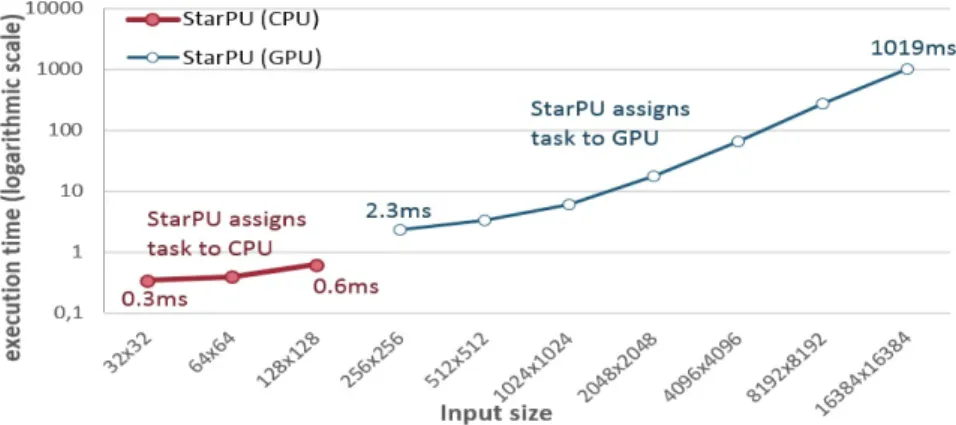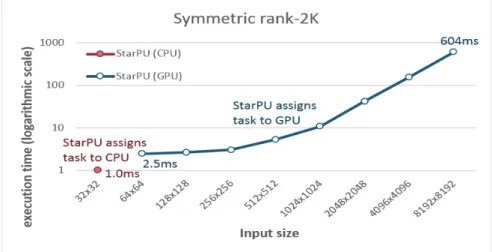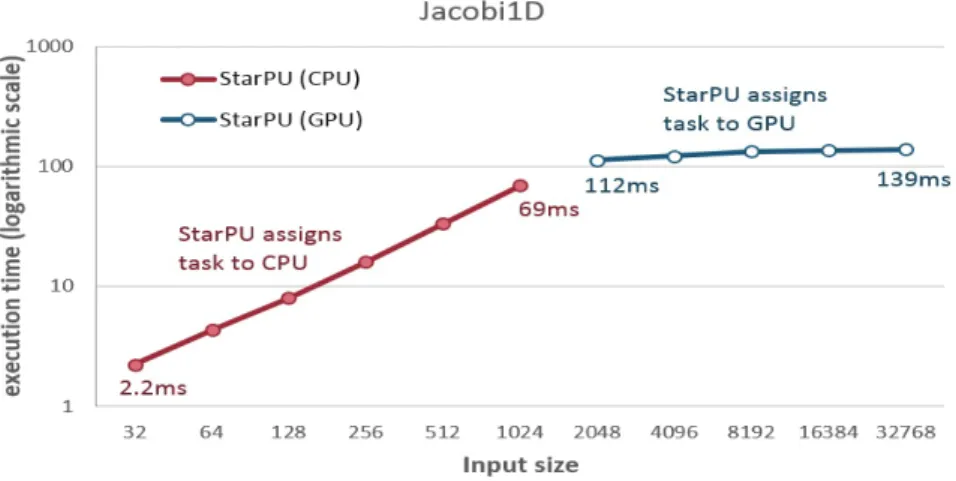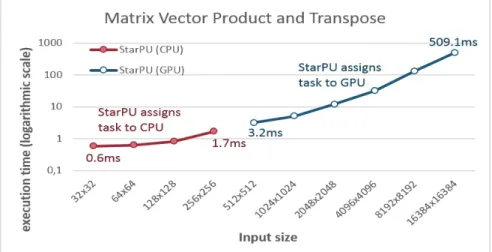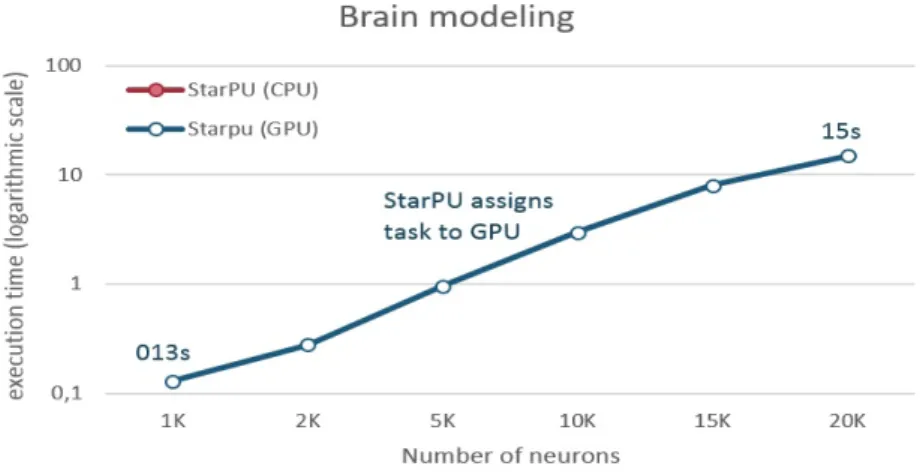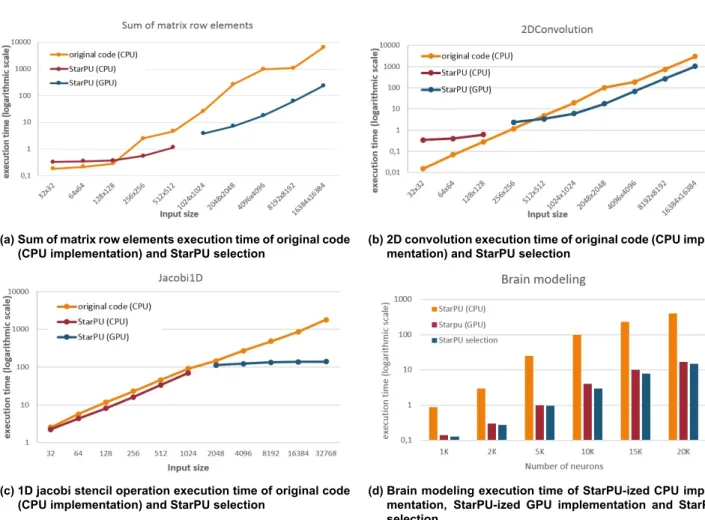Many parallel models have been proposed, the most promising being task-based models. Many task-based operating systems have been developed in an attempt to make better use of parallelism and achieve better performance. In the PRAM model, there is a group of processors connected to a shared memory, fed by a global clock.
In task-based parallel models, applications can break into tasks, with each task solving a part of the problem. A crucial role in task-based parallel models is played by the underlying runtime system (RTS), which includes the implementation mechanism. StarPU was applied to a set of applications (mostly linear algebra kernels) to demonstrate the flexibility of executing these kernels in heterogeneous systems based on StarPU's scheduling decisions.
The results of this work have been published in the 2nd International Workshop on Parallel Optimization with/for Multi and Manycore High Performance Computing (POMCO.
Motivation
On the other hand, in parallel programming, applications are developed specifically to exploit parallelism by using a parallel program. Some parallel programming models are parallel random access machine (PRAM), parallel data models and task-based parallel models [15]. The results of this work were published in the 2nd International Workshop on Parallel Optimization using/for Multi and Manycore High Performance Computing (POMCO 2020) [27].
First, we want to observe how task-based RTSs react to the kernel mainly used in HPC applications. Finally, we want to assess how easy it is for a user unfamiliar with RTS to use them.
Structure of the document
However, accelerators like GPUs have gained popularity and are being adopted in computing because of the benefits they provide. TDG is a directed acyclic graph (DAG), where nodes represent tasks and directed edges represent dependencies between tasks. Later, an RTS is responsible for assigning tasks to resources, such as CPU cores and accelerators, and managing data transfers.
This paradigm has been widely accepted and used because of the many advantages it offers. Automatic Task Scheduling: The task scheduler is mapping tasks to logical threads1 using higher-level information such as task dependencies, task types, etc., in order to avoid interference from other threads.
Taskbased models
The construct target and the clause device are used to specify that the implementation of the task is for a specific ar. OmpSs24 [2] is an extension of OmpSs [12], which is a combination of the OpenMP standard and StarSs. With the depend clause or with just the type of dependency as the name of the clause, task scheduling constraints are declared.
The first is used for the asynchronous execution of the tasks, with return type future
Comparison of features
Indicative results
- Codelet
- Data manipulation
- Task
- Codelet implementations
STARPU_MATRIX_GET_LD(descr[i]): Returns the number of elements between each row of the designated matrix. STARPU_MATRIX_GET_ELEMSIZE(descr[i]): Returns the size of the elements of the designated array. STARPU_BLOCK_GET_LDY(descr[i]): Returns the number of elements between each row of the designated block.
STARPU_BLOCK_GET_LDZ(desc[i]): Returns the number of elements between each z-plane in the designated block. STARPU_BLOCK_GET_ELEMSIZE(desc[i]): Returns the size of the elements in the designated block.
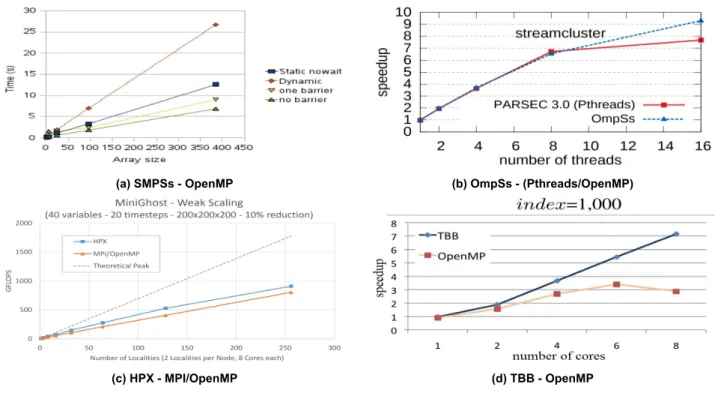
Performance models
STARPU_BLOCK_GET_PTR(descr[i]): Returns a pointer to the block (i.e. 3D matrix) defined by descr[i], a pointer to a block interface. The following lines show, in a general way, how to use those macros in the implementation function. The programmer must address the performance model within the codelet in the .model field.
It must also initialize the model in the main code by calling the starpu_perfmodel_init function. When using performance models, StarPU enforces code calibration to avoid wrong scheduling decisions. The programmer can enable or disable code calibration by setting the STARPU_CALIBRATE environment variable (exports STARPU_CALIBRATE = 1 or 0).
Scheduling policies
Once the configuration structure is set, StarPU's initialization method must be called with the configuration structure as an argument (starpu_init(&conf_name)).
A simple StarPUized example
StarPU in EXA2PRO
StarPU was applied to some Polybench benchmarks and two other applications to evaluate StarPU's scheduling decisions in heterogeneous systems. The final step was to run the applications in a heterogeneous node (CPU and GPU) for different input sizes and observe the scheduling decisions made by StarPU. The remainder of the chapter consists of the description of each application and its results.
Although this instruction was ultimately not used, sum of matrix row element applications, 2D convolution, and 1D jacobi stencil com. Codecs must manipulate two data buffers, one in read mode (window) and one in write mode (sum). In the digital domain, 2D convolution is performed between two two-dimensional signals by multiplying and summing the values of overlapping samples of the signals.
In the 2D convolution application, the input matrix A is convoluted with the kernel matrix c, and the result is stored in matrix B. The codelet must manipulate two data buffers (for the input and output matrices) in read and write mode, respectively. The computation grid in the core is the region [0, n − 1], where the stencil must be applied repeatedly over tsteps times.
The application defines two input arrays (A and B) and two output arrays (A_out and B_out) of float and n number of elements. In each iteration, array B caches the new values of A defined in the range [2, n − 2], and A contains the values from the previous iteration. After all the iterations are done, the final values are stored in the output arrays.
Matrix vector product and transpose
Symmetric rank2K operations
Brain modeling
Result evaluation
The scheduling decisions were based on the execution time of the kernels on the different processing units, because we used the history-based performance model. In the graphs, the x-axis corresponds to the input sizes of the applications (or the number of neurons in the case of the brain modeling application) and the y-axis to the execution time on a logarithmic scale. From the figures mentioned above, we see that StarPU has assigned small computing tasks to the CPU, while large computing tasks have been assigned to the GPU.
Figures 4.7a, 4.7b and 4.7c represent the execution time of the non StarPUized CPU implementation and the execution time of the StarPUized version of the sum of matrix row elements, 2D convolution and jacobi 1D applications respectively. From these figures, we notice that for small input sizes, the execution time of the StarPUized applications is worse than the non-StarPUized ones, due to the runtime system's. In addition, the execution time of StarPU's choice is slightly less than the one of the GPU implementations.
This means that the task's required data is requested to be transferred to the target processing unit once a scheduling decision has been made. As a result, the job does not have to wait for the data transfer to the target processing unit to complete, as data is already available.
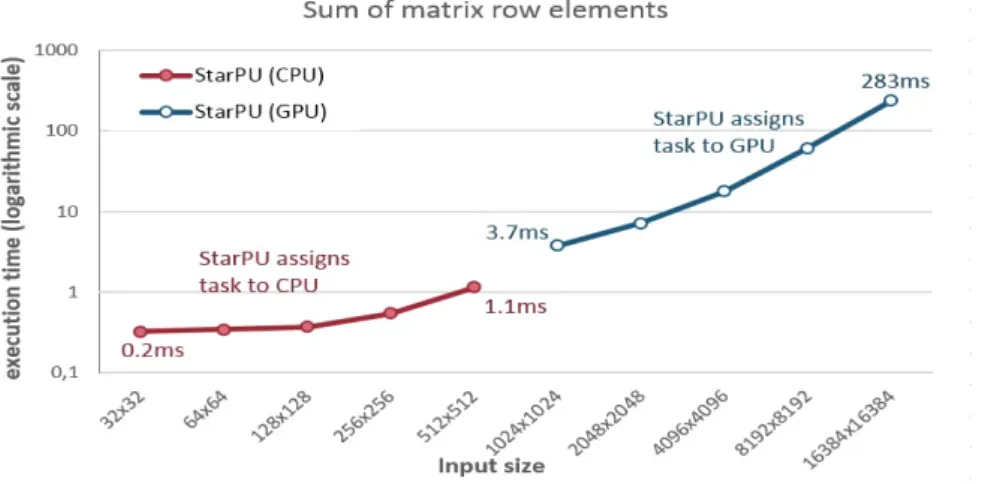
Training/programming effort
From this figure we can distinguish that the CEO. The time of the CPU implementation is greater than the GPU's implementation. Sum of matrix row elements execution time of original code (CPU implementation) and StarPU selection. The total number of source code lines required in each application for initializing and terminating StarPU, defining data handlers, submitting jobs, etc. was about 35.
Discussion
Indicative results of StarSs, OmpSs, HPX and TBB models
Sum of matrix row elements scheduling decisions
Matrix vector product and transpose scheduling decisions
Symmetric rank2D operations scheduling decisions
Brain modeling scheduling decisions
Comparison of execution time of original code and StarPUized
C program for vectors addition
Vector addition kernel, CPU implementation
StarPUized vector addition
Codelet of sum of matrix row elements application
C implementation kernel of sum of matrix row elements
Codelet of 2D convolution application
C implementation kernel of 2D convolution
Codelet of 1D jacobi stencil computation application
C implementation kernel of 1D jacobi stencil computation
Codelet of matrix vector product and transpose application
C implementation kernel of matrix vector product and transpose
Codelet of symmetric rank2K operations application
C implementation kernel of symmetric rank2K operations
Codelet of brain modeling application (part of the wrapper file generated by
C implementation kernel of brain modeling
Figures 4.7a, 4.7b and 4.7c represent the execution time of the non StarPUized CPU implementation and the execution time of the StarPUized version of the sum of matrix row elements, 2D convolution and jacobi 1D applications respectively. icized version, the execution times are those measured after StarPU's scheduling decision. From these figures, we notice that for small input sizes, the execution time of the StarPUized applications is worse than the non-StarPUized ones, due to the runtime system's. The results were controversial as the application used by ICCS did not show such good scalability, but the application used by CNRS showed good scalability. According to the research, scalability is affected by the task size, which is difficult to specify by the programmer.
This creates the need for more research on how task-based runtime systems can be more efficient for exascale systems. Although the above comments are for StarPU, we assume that similar conclusion can be drawn when using other task-based RTSs. The reason why it was decided to study task-based parallel models is that it is a promising solution to the challenges associated with today's multi-core heterogeneous architectures.
The aim of the thesis was to observe the scheduling decisions of StarPU in hetero. More specifically, we assigned and implemented the available application codes in StarPU and ran the applications in a heterogeneous node for different input sizes. The decisions were made based on the execution time of the kernels on each processing unit, where the execution time was affected by different factors, such as data transfer time.
First, it would be interesting to add more implementations of the applications, such as OpenCL, and StarPU's scheduling de. In addition, we can test whether the scheduling decisions would be different with the application of a different performance model. Finally, we can extend the applications to include more StarPU features, such as support for fault tolerance.
Sum of matrix row elements main code
Sum of matrix row elements CPU kernel implementation
Sum of matrix row elements GPU kernel implementation
116 /* StarPU no longer needs to manipulate the array and variables, so we can stop monitoring them. 134 /* StarPU no longer needs to manipulate vectors so we can stop monitoring them.
Matrix vector prodict and transpose main code
Matrix vector prodict and transpose CPU kernel implementation
Matrix vector prodict and transpose GPU kernel implementation
Symmetric rank2K operations main code
Symmetric rank2K operations CPU kernel implementation
Symmetric rank2K operations GPU kernel implementation
Brain modeling main code
87 Gjendja InnerDynamics_Integrate (const Constants parms , const State StatePrev , float iGapTotal , float time , float dt.
Brain modeling define functions
Brain modeling xml descriptor
Brain modeling parameter xml descriptor
Brain modeling CPU kernel implementation
The Impact of Memory Hierarchy on Shared Memory Architectures in Multicore Programming Models.2009 17th Euromicro International Conference on Parallel, Distributed and Network-Based Processing, p. InProceedings of IFIP International Conference on Network and Parallel Computing, NPC ’08, pages 266–275, Berlin, Heidelberg, 2008.
